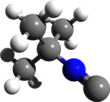| Revision as of 03:42, 22 March 2011 editCheMoBot (talk | contribs)Bots141,565 edits Updating {{chembox}} (no changed fields - added verified revid - updated 'UNII_Ref', 'ChemSpiderID_Ref', 'StdInChI_Ref', 'StdInChIKey_Ref', 'ChEMBL_Ref', 'KEGG_Ref') per Chem/Drugbox validation (← Previous edit | Revision as of 16:58, 27 November 2011 edit undoThe chemistds (talk | contribs)Extended confirmed users5,761 edits added CSID, (Std)InChI & (Std)InChIKeyNext edit → | ||
| Line 11: | Line 11: | ||
| | CASNo_Ref = {{cascite}} | | CASNo_Ref = {{cascite}} | ||
| | CASNo = 7188-38-7 | | CASNo = 7188-38-7 | ||
| | PubChem = 23577 | |||
| | ChemSpiderID = 22045 | |||
| | SMILES = CC(C)(C)# | |||
| | InChI = 1/C5H9N/c1-5(2,3)6-4/h1-3H3 | |||
| | InChIKey = FAGLEPBREOXSAC-UHFFFAOYAL | |||
| | StdInChI = 1S/C5H9N/c1-5(2,3)6-4/h1-3H3 | |||
| | StdInChIKey = FAGLEPBREOXSAC-UHFFFAOYSA-N | |||
| }} | }} | ||
| | Section2 = {{Chembox Properties | | Section2 = {{Chembox Properties | ||
Revision as of 16:58, 27 November 2011
| |||
| Names | |||
|---|---|---|---|
| Other names t-BuNC, propane, 2-isocyano-2-methyl | |||
| Identifiers | |||
| CAS Number | |||
| 3D model (JSmol) | |||
| ChemSpider | |||
| ECHA InfoCard | 100.027.776 | ||
| PubChem CID | |||
| CompTox Dashboard (EPA) | |||
InChI
| |||
SMILES
| |||
| Properties | |||
| Chemical formula | C5H9N | ||
| Molar mass | 83.13 g/mol | ||
| Appearance | Colorless liquid | ||
| Density | 0.735 g/cm³, liquid | ||
| Melting point | ? °C | ||
| Boiling point | 91 °C | ||
| Solubility in water | N/A | ||
| Except where otherwise noted, data are given for materials in their standard state (at 25 °C , 100 kPa).
| |||
tert-Butyl isocyanide is an organic compound with the formula Me3CNC (Me = methyl, CH3). It is an isocyanide, commonly called isonitrile or carbylamine, as defined by the functional group C≡N-R. tert-Butyl isocyanide, like most alkyl isocyanides, is a reactive colorless liquid with an extremely unpleasant odor. It forms stable complexes with transition metals and can insert into metal-carbon bonds.
tert-Butyl isocyanide is prepared by a Hofmann carbylamine reaction. In this conversion, a dichloromethane solution of tert-butylamine is treated with chloroform and aqueous sodium hydroxide in the presence of catalytic amount of the phase transfer catalyst benzyltriethylammonium chloride.
- Me3CNH2 + CHCl3 + 3 NaOH → Me3CNC + 3 NaCl + 3 H2O
tert-Butyl isocyanide is isomeric with pivalonitrile, also known as tert-butyl cyanide.
Coordination chemistry
By virtue of the lone electron pair on carbon, isocyanides serves as ligands in coordination chemistry, especially with metals in the 0, +1, and +2 oxidation states. tert-Butyl isocyanide has been shown to stabilize metals in unusual oxidation states, such as Pd(I).
- Pd(dba)2 + PdCl2(C6H5CN)2 + 4 t-BuNC → 2 + 2 dba + 2 C6H5CN
tert-Butyl isocyanide can form hepta-coordinate homoleptic complexes, despite having a large t-Bu group, which is held far away from the metal center because of the linearity of the M-C≡N-C linkages.
Similarity to metal carbonyls
tert-Butyl isocycanide forms complexes that are stoichiometrically analogous to certain binary metal carbonyl complexes, such as Fe2(CO)9 and Fe2(tBuNC)9. Although structurally similar, the analogous carbonyls differ in several ways, mainly because t-BuNC is a better donor ligand than CO. Thus, Fe(tBuNC)5 is easily protonated, whereas its counterpart Fe(CO)5 is not.
Insertion into metal-carbon bonds
Under certain circumstances, tert-butyl isocyanide has been shown to insert into metal-carbon bonds to form iminoacyls. The insertion of isocyanides into metal-carbon bonds is of potential relevance in organic synthesis.
Safety
In keeping with its similarity to carbon monoxide, tert-butyl isocyanide is toxic.
References
- Malatesta, L. Isocyanide Complexes of MetalsProgress in Inorganic Chemistry, 1959, volume 1, 284-291.
- Gokel, G.W.; Widera, R.P.; Weber, W.P. (1988). "Phase-transfer Hofmann carbylamine reaction: tert-butyl isocyanide". Organic Syntheses
{{cite journal}}: CS1 maint: multiple names: authors list (link); Collected Volumes, vol. 6, p. 232. - Rettig, M.F.; Maitlis, P.M.; Cotton, F.A.; Webb, T.R. Tetrakis(tert-butyl isocyanide)Di-μ-chloro-dipalladium(I). Inorganic Syntheses, 1990, 28, 110-113. ISBN 0-470-13259-0. doi:10.1002/9780470132593.ch29
- Carnahan, E.M.; Protasiewicz, J.D.; Lippard, S.J. 15 years of reductive coupling: what have we learned? Acc. Chem. Res. 1993, 26, 90-97
- Bassett, J.M.; Barker, G.K.; Green, M.; Howard, J.A.; Stone, G.A.; Wolsey, W.C. "Chemistry of low-valent metal isocyanide complexes" J.C.S. Dalton, 1981, 219-227.
- Bassett, J.M.; Farrugia, L.J.; Stone, G.A. "Protonation of pentakis(t-butyl isocyanide)iron" J.C.S. Dalton, 1980, 1789-1790.
- Vicente, J; Abad, J.A.; Fortsch, W.; Lopez-Saez, M.J. Reactivity of ortho-palladated phenol derivatives with unsaturated molecules. Organometallics, 2004, 23, 4414-4429. DOI 10.1021/om0496131.

